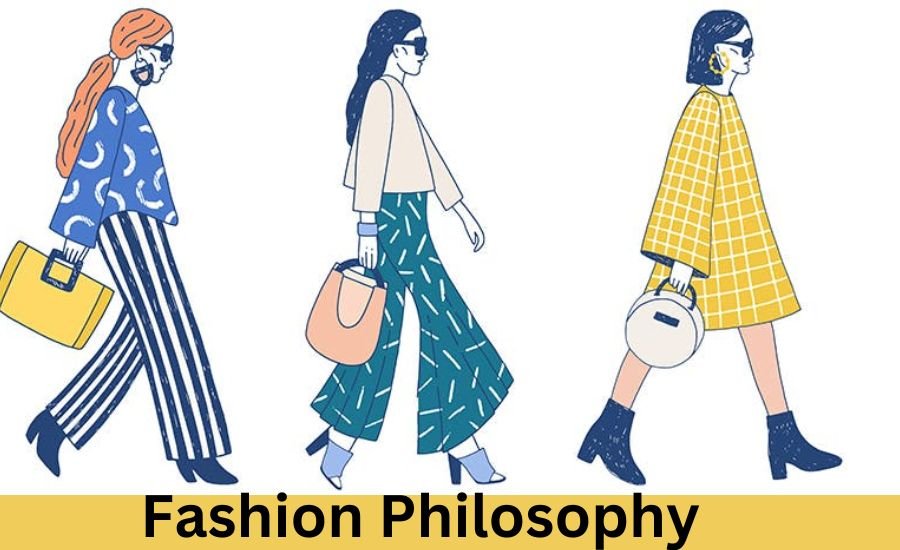Fashion philosophy is more than just about trends and aesthetics—it is a deep exploration of how clothing reflects personal identity, cultural values, and social change. Throughout history, fashion philosophy has influenced the way individuals express themselves and how societies evolve through style.
From ancient civilizations to modern-day streetwear, fashion philosophy has shaped how we perceive beauty, status, and self-expression. It’s not just about what we wear but also about why we wear it. Understanding fashion philosophy can help us appreciate the deeper meaning behind our clothing choices and their impact on the world.
The Evolution of Fashion Philosophy: From Ancient Times to Modern Trends
Fashion has always been a reflection of culture and society. In ancient times, clothing was not just about covering the body—it symbolized status, beliefs, and identity. Egyptian pharaohs wore elaborate outfits to display power, while Roman togas represented citizenship and honor. These early fashion choices laid the foundation for how clothing would be used to express deeper meanings.
During the Renaissance, fashion evolved into an art form. Rich fabrics, intricate embroidery, and unique styles became a way to showcase wealth and creativity. As societies changed, fashion philosophy also adapted. The Industrial Revolution made clothing more accessible, and new styles emerged to represent individuality and progress.
Modern fashion is driven by self-expression, innovation, and sustainability. With fast fashion dominating the industry, many people question its ethical impact. Today, designers focus on creating clothing that balances aesthetics with responsibility. Fashion is no longer just about trends—it’s about making statements that shape the future.
Fashion as a Form of Self-Expression: More Than Just Clothing
Clothing is a powerful way to communicate personality and emotions. The colors, fabrics, and styles we choose reflect how we feel and what we want to express. Some people use bold outfits to stand out, while others prefer minimal designs for a classic and timeless look.
Throughout history, people have used fashion to challenge norms. Punk rockers, hip-hop artists, and activists have all worn specific styles to make statements about society. Fashion philosophy helps us understand why certain styles resonate with different groups.
Social media has changed the way people express themselves through fashion. Influencers, designers, and everyday individuals use platforms like Instagram to showcase unique styles. With so many choices, fashion has become a tool for storytelling and individuality.
The Role of Aesthetics in Fashion Philosophy: Beauty vs. Meaning
Aesthetics play a major role in fashion. Some people believe beauty is the most important factor in clothing, while others think meaning and purpose matter more. Throughout history, designers have debated whether fashion should focus on looking good or making a statement.
| Fashion Approach | Key Features | Philosophy |
| Minimalist Style | Clean lines, neutral colors, timeless pieces | Focuses on simplicity and elegance |
| Avant-Garde Fashion | Bold designs, unusual materials, unexpected patterns | Embraces creativity and challenges norms |
| Inclusive Fashion | Diverse models, body-positive designs, cultural representation | Moves away from traditional beauty standards |
Fashion also influences the way people perceive beauty. Trends change constantly, shaping what is considered attractive. However, many designers today are moving away from traditional beauty standards. They aim to create fashion that is inclusive, diverse, and meaningful.
Cultural Influence on Fashion Philosophy: How Traditions Shape Style
Every culture has a unique approach to fashion. Traditional clothing reflects history, values, and beliefs. In many Asian countries, garments like the kimono and sari are not just outfits—they are symbols of heritage. Similarly, African textiles showcase bold patterns that tell stories of the past.
As cultures interact, fashion evolves. Western styles often borrow elements from different regions, creating fusion fashion. Designers mix traditional fabrics with modern silhouettes to celebrate cultural diversity. This blending of styles leads to new fashion trends that connect people worldwide.
Globalization has made Fashion more accessible, but it has also raised concerns about cultural appropriation. Fashion philosophy encourages people to respect and appreciate cultural styles rather than exploiting them for trends. Learning about the history behind different clothing helps people make informed and respectful fashion choices.
The Ethics of Fashion: Sustainability, Consumerism, and Moral Choices

Fast fashion has made clothing affordable, but it has also created ethical concerns. Many factories exploit workers, use harmful materials, and produce waste that damages the environment. The demand for cheap clothing has led to overproduction, pollution, and unfair labor practices.
Sustainable fashion is becoming a solution to these problems. Designers now use organic fabrics, recycled materials, and ethical production methods. Many brands promote slow fashion, encouraging people to buy fewer but higher-quality items that last longer.
Consumers play a big role in ethical fashion. Choosing sustainable brands, supporting local designers, and being mindful of purchases can help create a better industry. Fashion philosophy teaches that what we wear should reflect our values, not just our style.
Gender and Fashion Philosophy: Breaking Stereotypes Through Style
Fashion has long been linked to gender roles. In the past, men and women were expected to dress in specific ways. However, modern fashion challenges these expectations. Unisex clothing, gender-fluid designs, and breaking dress codes have become more common.
Historically, clothing defined social roles. Dresses were seen as feminine, while suits represented masculinity. Today, many designers create gender-neutral fashion to allow more freedom in self-expression. This shift is changing the way people view clothing.
Celebrities and influencers have played a big role in breaking gender norms. Many wear outfits that challenge traditional expectations, inspiring others to do the same. Fashion philosophy now embraces diversity, encouraging people to wear what makes them feel comfortable and confident.
The Psychology of Fashion: How Clothes Influence Mood and Behavior
What we wear affects how we feel. Studies show that colors, textures, and styles can change our emotions. Bright colors like red and yellow create energy, while darker tones like blue and black bring a sense of calm.
Fashion also affects confidence. Wearing well-fitted clothing can make people feel more powerful and self-assured. Many professionals use fashion as a tool to boost their presence in social and work settings.
Psychologists believe that dressing for success is real. People who wear outfits they love often perform better in daily activities. Understanding the psychology behind fashion helps people make choices that positively impact their lives.
Minimalism vs. Maximalism: Two Opposing Fashion Philosophies
Fashion comes in two main styles—minimalism and maximalism. Minimalist fashion focuses on simple, timeless pieces. It avoids excess, promoting a clean and elegant look. People who love minimalism prefer neutral colors, sleek designs, and quality over quantity.
Maximalism is the opposite. It embraces bold prints, vibrant colors, and layering multiple accessories. This style celebrates creativity and personal expression. Many designers use maximalist fashion to make bold statements.
Both styles have their place in fashion philosophy. Some believe minimalism creates a sense of peace, while others think maximalism represents fun and individuality. Personal preference plays a big role in which style people choose.
How Fashion Reflects Social and Political Movements
Clothing has always been a tool for social change. Throughout history, people have used fashion to protest, make statements, and challenge norms. For example, the 1920s flapper style represented women’s freedom and independence.
During the civil rights movement, activists wore clothing that symbolized unity and strength. More recently, movements like gender equality and body positivity have influenced fashion trends. T-shirts with slogans, symbolic colors, and unique styles help people express their beliefs.
Fashion is not just about style—it’s a way to communicate ideas. Designers often create collections inspired by political issues, making fashion a powerful tool for awareness. The way people dress can reflect the changes they want to see in the world.
The Future of Fashion Philosophy: Where is Style Heading?

The fashion industry is constantly evolving. New technologies, sustainability, and changing values are shaping the future of style. Smart fabrics, 3D printing, and digital fashion are transforming how clothing is made and worn.
Sustainability is becoming more important. Many designers focus on reducing waste, creating biodegradable materials, and promoting ethical production. People are also embracing second-hand clothing to reduce fashion’s environmental impact.
Fashion philosophy is moving toward inclusivity, innovation, and responsibility. The future of fashion is not just about looking good—it’s about making choices that benefit individuals and the planet.
Conclusion
Fashion is more than just clothes—it is a way to show who we are and what we believe. From ancient times to today, people have used fashion to express feelings, culture, and ideas. Fashion philosophy helps us understand why we wear certain styles and how clothing shapes the world around us. Whether through simple outfits or bold designs, fashion tells a story about each person and society as a whole.
The future of fashion is exciting and full of change. As people focus on sustainability, creativity, and self-expression, fashion will continue to evolve. Choosing what to wear is not just about looking good—it is about making choices that feel right and have meaning. No matter the trends, fashion will always be a powerful way to share our identity and make an impact on the world.
FAQs
Q: What is fashion philosophy?
A: Fashion philosophy is the study of how clothing reflects identity, culture, and beliefs. It explores the meaning behind fashion choices and how they shape society.
Q: Why is fashion important in self-expression?
A: Fashion allows people to express their personality, emotions, and values. The way we dress can show confidence, creativity, or cultural identity.
Q: How does fashion influence society?
A: Fashion reflects social changes, trends, and history. It can challenge norms, support movements, and bring people together through shared styles.
Q: What role does sustainability play in fashion?
A: Sustainable fashion focuses on ethical production, reducing waste, and using eco-friendly materials to protect the environment.
Q: How does culture affect fashion?
A: Different cultures have unique clothing styles that represent traditions and history. Many fashion trends are inspired by cultural influences.
Q: What is the difference between minimalism and maximalism in fashion?
A: Minimalism focuses on simple, timeless pieces, while maximalism embraces bold colors, patterns, and layers for a striking look.
Q: How do clothes affect our mood and confidence?
A: Wearing certain colors and styles can influence emotions. Well-fitted, comfortable clothing often boosts confidence and self-esteem.
Q: What is the future of fashion philosophy?
A: The future of fashion includes more sustainability, inclusivity, and technology-driven designs, making fashion both stylish and responsible.

1 thought on “Fashion Philosophy: Unlocking the Remarkable Power of Style, Identity & Self-Expression!”